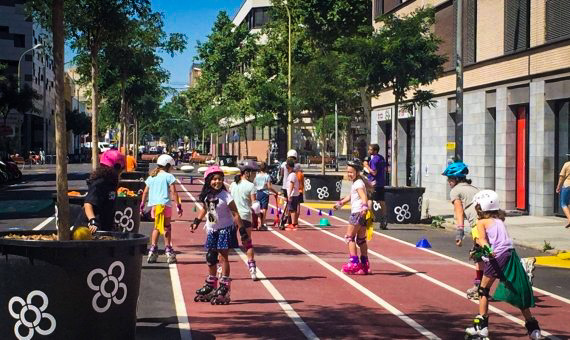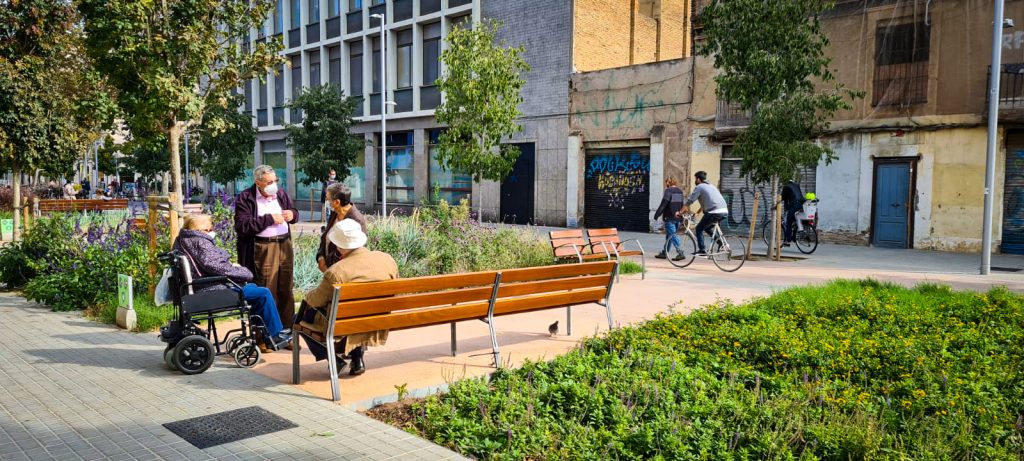Giving the streets back to the people: The Spanish idea of creating city blocks where cars are only allowed as guests is spreading across Europe. But what’s the story behind the superblocks, and how can you translate it to your city?
In 2014, Barcelona introduced a new mobility plan to help the car-clogged city conquer problems like air pollution and congestion. Barcelona has persistently failed to meet the EU-established air quality targets and lacks green space, with only 6.6sq metres of accessible green space per inhabitant. To put this into perspective: London offers 27sq metres and Amsterdam 87,5sq metres of green spaces per inhabitant.
The new mobility plan focuses on reducing traffic by 21% and freeing up 60% of streets used by cars to turn them into spaces for citizens. To achieve that, the plan includes the so-called superille (superblocks), a concept developed by Salvador Rueda, the director of the Urban Ecology Agency of Barcelona. The city worked on the idea from 2015 until late 2016 before implementing the first superblock in the district of Poblenou.
What is a Superblock?
A superblock is a city block without transit, limited traffic, and many green, public spaces. Barcelona’s city infrastructure is very strictly organised, looking like a chessboard when viewed from above. Hence, urban planners were able to turn grids of three by three similar-sized streets into a superblock.
In a superblock, public transit is not allowed to enter, but the city rearranged the bus network so that public transportation is easily accessible at the superblock’s outer edges. Contrary to popular belief, cars can enter the superblock but are only allowed to turn right. With these one-way streets and 20km/h maximum speed limits, mostly 10km/h, traffic is reduced significantly. Additionally, there are no traffic lights in the superblock, so drivers are forced to seek eye contact with pedestrians which makes them feel much safer.
The space created by banning public transport and slowing cars down is used for playgrounds, benches and tables, trees, and running tracks. All changes focused on the people, the community, and the increase of liveability in the neighbourhood.
Getting People on Board With Communication
We spoke to Patrick Kappert, a member of the voluntary organisation Col·lectiu Superilla Poblenou, to learn more about the implementation process in Poblenou.
Did people welcome the changes with open arms and embrace them? Quite the opposite was the case. There was news coverage of people not being able to get to work, concerns of neighbours that ambulances would not get to those in need, and town meetings that critics overran. That is how the story of Col·lectiu Superilla Poblenou began. Together with other neighbourhood residents, Patrick Kapper started to organise and show the locals the new potential of this idea.
Patrick sees the reason for the outrage clearly in the failed communication by the city: “They didn’t give proper information to the neighbours at all. They also didn’t ask for any of our opinions. There was just some poster down in the hall where I live, saying from Monday on this is a superblock, and this is the way you have to drive.” With a huge movement on Twitter and national negative media coverage, the superblock was off to a rocky start.
However, with the help of Col·lectiu Superilla Poblenou, people in the neighbourhood started proposing ideas to the city on how to rearrange space and how to fill the empty spaces with vegetable gardens and playgrounds.
And They Lived Happily Ever After…
Attitudes changed within the first year: “When they created the first playground, all neighbours started to see the change, and the publications of the superblocks began to be positive.” Now, almost four years later, Patrick assures us that no one wants to go back to how it was before.
The superblock became a great place to live – Patrick gushes about the rise of liberations of the neighbourhood where “the street is a meeting point.” Picnic tables in the superblock are being used 24/7. As there are many offices in the area, workers have their business meetings in the middle of the street, and in the evening, residents are out there drinking and enjoying each other’s company.
“The street also has to be a place to meet, not only a place to move”
Patrick Kappert



It’s not only residents benefiting from the superblocks, but people living in districts close-by also come to Poblenou to enjoy a walk with their grandparents or teach their children how to ride a bike on the streets.
Communication and Gentrification
Whenever a neighbourhood is transformed, the fear of gentrification comes with it: The improvement of an area is likely to lure wealthy people there, leading to higher rents and living costs and former residents moving away. How can this be prevented?
The city of Barcelona partly chose this specific neighbourhood because besides offices, all houses built after 2000 were social housing units. Even though gentrification is a big problem in Barcelona, Patrick has his own take on things: “To people who say you cannot make superblocks because of the gentrification, I say, what is your proposal then…Make it a nasty place to live with poor quality of life?”
The problem is not the superblock, the challenge is to prevent gentrification from happening as soon as the superblock exists. If you break it down, the solution is quite obvious: “Improve all the neighbourhoods, especially the ones that have the poorest quality.”
Everyone should be able to live in a nice neighbourhood. As Patrick puts it, “it should be a civil right for the people who live in towns to have places where they can relax in the public space.”
Before improving all neighbourhoods, putting superblocks in spaces with social housing and ensuring that living costs will stay the same, is an excellent first step nonetheless.
Supergrätzl and Kiezblock: Bringing Superblocks to Other Cities
The superblock concept has caught a lot of international attention, with cities aiming to translate the solution to their local context.
Vienna is currently working on a similar concept, figuring out how the superblocks can be implemented in Austria’s capital as Supergrätzl. While the city is figuring out the details, citizens were able to get informed and weigh in with their ideas during the European Mobility Week in September.
We talked about the strict chessboard-like street grids in Barcelona – well, Vienna does not have these. Could superblocks even be implemented in Vienna, then? The answer is yes.
Early in 2020, city planner Florian Lorenz published a research project together with the Vienna University of Technology on how superblocks could help Vienna become more energy-efficient. In this research project, many parts of Vienna were identified that meet the requirements to be transformed into superblocks. Additionally, the research underlined that as the energy consumption in the traffic sector in Austria is on the rise, superblocks are necessary to reduce emissions and improve liveability.
Whilst Vienna is still figuring out the details of its version of the superblocks, Berlin’s residents have taken it a step further. While Berlin’s politicians are still working on a model to create low traffic neighbourhoods in the district of Prenzlauer Berg, residents of another Berlin district Bergmannkiez, took the transformation into their own hands.
Through a citizen’s petition with 1.106 signatures, the residents were able to transform their block into a low traffic neighbourhood. With small measures, such as tempo limits, one-way streets and barriers for the cars, the residents regained control over the streets without complex politics and testing periods. Changing Cities created the campaign for the so-called kiezblocks and offers help to other Berlin residents who want to achieve something similar.
To find out how you can do the same, check out our article on “how to create a low-traffic neighbourhood”.
Advice for CityChangers
We asked Patrick for advice on how to implement superblocks in other cities. His answer was pretty simple: “Just do it”. “You will have the press against you because the lobby of the cars is immense…but it takes about half a year until the press starts announcing the good news, talking with people that are happy they live here. So just do it, don’t be afraid.”
The second part of his advice proves just as important: You have to talk to the residents and ask them what they want. It all starts and ends with communication and citizen involvement.
Lastly, Patrick thinks that “it should be a project that is connected. Having one superblock as a tourist attraction in one place is not working; it should be all over the place.”
If you got hooked and want to know more about Barcelona’s urban planning, we can recommend this article about the history of Barcelona’s urbanisation.



Such an interesting read!